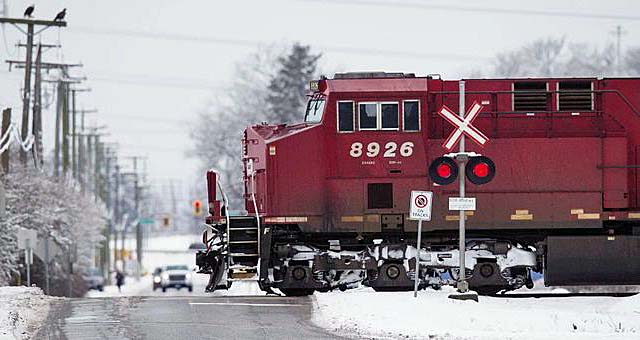
Bruderheim Alberta - Town council was making some noise about train whistles being blown in the community.
The issue was brought up during a presentation by Mike LoVecchio, director of government affairs for Canadian Pacific Railway (CP), during the 17 Jan 2018
meeting.
LoVecchio wanted a chance to introduce himself to the new members of council following the October civic election while providing an overview of what CP offers
to the community and neighbouring industries.
Both CP and Canadian National Railway operate rail lines in and around Bruderheim.
During the presentation, the issue of the train whistle was brought up.
Mayor Karl Hauch suggested the company look at new technologies to help address any concerns around whistle noises.
"If you had a remote control that was at the crossing that made that noise, only at that crossing rather than four or five hundred feet away where there
are a bunch of residents waking up at three in the morning," he said.
"Instead, right at the crossing, press a button and that thing would go off. It wouldn't be expensive technology. Maybe it is something you can think
about as you are a world leader in safety."
LoVecchio told council the whistle post is about a quarter mile away from the town's crossing.
CP employees have to sound the whistle three times before getting to the crossing and then again once they enter the crossing.
"The require to whistle is not a CP requirement, to be clear, it is a requirement in the Canadian Railway Operating rules," he said.
"The rules that govern all train operations in Canada and endorsed by Transport Canada. I agree with you there is technology that could maybe not
eliminate but reduce the amount of whistling. That discussion has to occur with the regulator."
Council also heard that a train cannot sit in a crossing for more than five minutes when vehicles or pedestrian traffic needs to get by.
If emergency vehicles needs to pass, rail employees must cooperate to quickly clear the crossing.
LoVecchio boasted that CP is a leader when it comes to rail safety for more than a decade.
According to his slide, the number of train accident frequency per million train-miles has steadily gone down over the past few years.
Over a five year period, the number has dropped from 1.69 in 2012 to 0.97 in 2016.
The highest rate was in 2013 at 1.80.
Personal injuries per 200,000 employee-hours has fluctuated more over that same time period with 2012 at 1.56 and 2016 at 1.64.
The highest recorded in that time was in 2015 at 1.84.
LoVecchio said the same trend can be seen with 2017, although at the time the numbers weren't yet released.
"It is a key focus within the company and one of our core values," he said.
"I was once asked by a regulator if I could provide a copy of our safety management plan to them. I said OK get your warehouse ready because it is in
every document, it is part of our operating philosophy. There's strong motive for that not only because it is the appropriate approach. We only make money if
we move things from A to B to C to D. If for some reason there's a blockage say from a derailment, that impacts our bottom line."
LoVecchio pointed out the majority of railway incidents are caused by human factors.
Over a 10 year period, human factors continued to rise while track, equipment, and environmental factors decreased.
In 2015, roughly 54 percent of incidents were caused by human factor as opposed to 49 percent in 2014 and 49.4 percent in 2013.
The lowest was in 2005 at 43.7 percent.
LoVecchio said the company is looking into ways to improve these numbers including looking at installing cameras facing inwards to watch and listen to
conductors.
Before any rail company can do this, Ottawa needs to give the green light, which LoVecchio hopes will happen this spring.
Lindsay Morey.
under the provisions in
Section 29 of the Canadian
Copyright Modernization Act.



